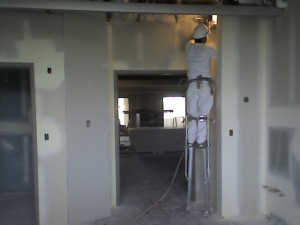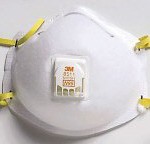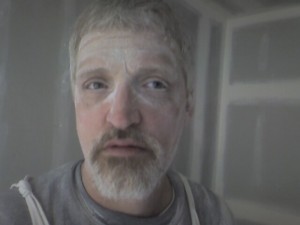Tue 16 Nov 2010
Drywall Sanding – silica & dust exposures
Posted by admin under Drywall, Paper Dust Masks, Personal Protective Equip (PPE), Respirators, Silica
[3] Comments
I have done a bunch of respirable silica dust air monitoring during drywall sanding activities.  I have found varying results from the data (meaning overexposures & within the exposure limits). I have found silica in the drywall mud (or possibly the drywall itself). I have also found that most drywall sanders wear a paper dust mask. In recent years I have not found any airborne silica in my samples. However! I have found airborne (total) dust levels higher than five times the exposure limits during sanding. What does this mean?
I have found varying results from the data (meaning overexposures & within the exposure limits). I have found silica in the drywall mud (or possibly the drywall itself). I have also found that most drywall sanders wear a paper dust mask. In recent years I have not found any airborne silica in my samples. However! I have found airborne (total) dust levels higher than five times the exposure limits during sanding. What does this mean?
Well, the issue is that most drywall sanders use paper dust masks , or equivalent N95 or P100. Like this.
, or equivalent N95 or P100. Like this.
NIOSH has rated these masks for a protection factor of 5. Meaning that you are “allowed” to be exposed up to 5 times the exposure limit. IMO there are many things wrong with these masks. For starters, their fit on your face is really a guess. There are no “tried-and-true” methods for assuring these masks fit.*Â Second, if you admit that you need to wear a respirator (meaning: you need to protect yourself) why would you choose an inferior product? I could go on…
Therefore, or finally, we come to my recommendations:
- if you’re drywall sanding:Â wear a 1/2 face tight fitting respirator with HEPA cartridges. It will protect you (given a proper fit) and based on my findings, you can rest assured you won’t be overexposed.
Besides who wants to look like this at the end of the day?
*Quantitative fit testing is a reliable fit test method, but for these types of masks, I find it to be totally useless in the real-world

Wonderful writing! You have got the talent of creative writing. I personally liked the summarization especially the perfect drafting of brilliant ideas.And yes i have bookmarked your site http://www.ihconstruction.com .
I agree with your points , great post.
I blog quite often and I seriously appreciate your information.
The article has truly peaked my interest. I’m going to book mark your website and keep checking for new details about once per week. I subscribed to your Feed too.